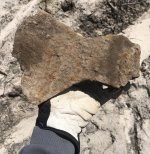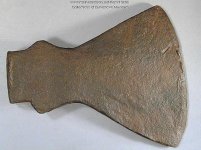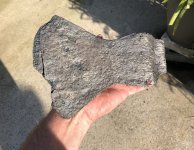cellerfeller
Full Member
- May 15, 2019
- 105
- 201
- Detector(s) used
- Garrett Ace 400i
- Primary Interest:
- All Treasure Hunting
This is a recent find from a celler hole that dates back to the late 1700's. I have never found this pattern before - you can see how it was handl forged. It is 7 1/4" X 4 7/8" across the blade. It is unusual the way it folds back to make the eye. I had hunted this celler site many times but there is a heavy nail bed so I switched to a small sniper coil and was able to pull a new signal out to dig. Couldn't believe it when this came up. As always any help would be greatly appreciated.












